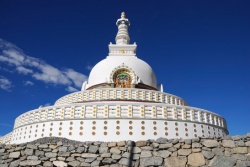Cetiyapabbata
Also called Cetiyagiri. The later name of the Missaka mountain given on account of its many shrines. Devānampiyatissa built a vihāra there - the second vihāra in Ceylon - for Mahinda and those ordained under him (Mhv.xvi.12-17).
The relics, obtained by Sumanasāmanera from Asoka and from Sakka, were deposited there until they were needed.
According to the Mahāvamsa (Mhv.xxii.23ff) this fact was the occasion for the name.
One of the eight saplings of the Sacred Bodhi-tree at Anurādhapura was planted in the drama on Cetiyagiri (Mhv.xix.62).
Mahinda spent the last years of his life on Cetiyagiri and died there, and there his relics were enshrined (Mhv.xx.32, 45).
Near the mountain was the village of Dvāramandala (Mhv.xxiii.23).
Kutakannatissa built an uposatha-hall on the mountain and planted a Bodhi-tree, while Bhāti-kābhaya supplied food daily to one thousand monks dwelling there (Mhv.xxxiv.30f, 64), and Lañjakatissa had the vihāra paved at a cost of one hundred thousand (Mhv.xxxiii.25).
Mahādāthikamahānāga made four gateways and a road round the mountain, and held the Giribhandapūjā with great pomp and ceremony; it is said that in order that the people might approach the mountain with clean feet he spread carpets right up to it from the Kadamba River (Mhv.xxxiv.75ff).
Kanirajānutissa had sixty monks of Cetiyapabbata put to death as traitors by flinging them into the cave called Kanira (Mhv.xxxv.11).
Vasabha provided four thousand lamps to be lighted on Cetiyagiri (Mhv.xxxv.80), while Jetthatissa gave to the vihāra the income derived from the Kālamattika Tank. (Mhv.xxxvi.130; see also Dpv.xv.69; xvii.90; xix.13, and Sp.i.82ff).
In the time of Kakusandha, Cetiyagiri was known as Devakūta, in that of Konāgamana as Suvannakūta, and in that of Kassapa as Subhakūta (Sp.i.86f).
The Dhammarucikas once occupied the Ambatthalavihāra on Cetiyapabbata, it having been given to them by Dhātusena (Cv.xxxviii.75).
Aggabodhi supplied a permanent supply of water for the bathing-tank called Nāgasondi, on the top of Cetiyagiri (Cv.xlii.28; see Cv. Trs.i.68, n.8), while Aggabodhi III. gave to the vihāra the village of Ambillapadara (Cv.xliv.122).
Aggabodhi V. restored the ruined buildings of Cetiyapabbata at a cost of one hundred and twenty thousand pieces (Cv.xlviii.7), while the queen of Udaya I, built there the Kanthakacetiya, and her husband decorated the mountain with brightly coloured flags and streamers (Cv.xlix.23, 27).
Sena I, gave to the monastery the income from the Kānavāpi (Cv.l.72), and Sena II.
Provided a hospital for the use of the monks there (Cv.li.73). Kassapa VI. built the Hadayunha Parivena and gifted it to the Dhammarucikas (Cv.lii.18).
Parakkamabāhu I restored all the old buildings which had been destroyed and built sixty-four thūpas (Cv.lxxviii.108).
The Commentaries relate several anecdotes connected with Cetiyapabbata. Maliyadeva Thera recited there the Chachakka Sutta, and sixty listening bhikkhus became arahants (MA.ii.1064).
Lomasanāga Theca lived in the Padhānaghara in the Piyanguguhā there and overcame the cold he felt by meditating on the Lokantarikaniraya (MA.i.65).
Cetiyapabbata was the residence of Kālabuddharakkhita, and King Saddhātissa spent some time there (MA.i.469f.
See also Vsm.20, 64; DhSA.194, 200; AA.i.44).
At the time that Fa Hsien came to Ceylon there were two thousand monks in Cetiyagiri, including a monk of great fame, called Dharmagupta (Giles: p.72).
Source
http://www.palikanon.com/english/pali_names/c/cetiyapabbata.htm

